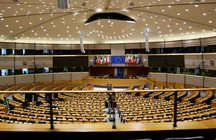The plenary of the European Parliament approves the agreement on the mid-term review of the Multiannual Financial Framework 2021-2027 reached with the Council. In addition to the 50 billion for Ukraine, the MFF mid-term review increases allocations for migration, defense and emergency aid. Limited investment in STEP, which - with the exception of European Defense Fund investments - only gets more flexible use of already available European funding. While several programmes - from Horizon to NDCI - lose resources to fund new priorities.
The plenary vote formalizes the understanding between the EP and member states reached on February 6 and preceded by agreement among the 27 at the February 1 European Council, which broke the deadlock on the revision of the 2021-27 Multiannual Financial Framework initially brought about by Budapest's no to aid for Ukraine.
The European Parliament's green light, with 499 votes in favor, 67 against and 31 abstentions, must now be followed by the Council's final vote.
The EU Commission's proposed mid-term review of the MFF 2021-2027
The European budget adopted in 2020 has used its flexibility margins to the limit: after the management of the Covid crisis and the initial responses to the war in Ukraine, now the MFF is being challenged by rising inflation and interest rates, which among other things are also increasing the financing costs of Next Generation EU.
With the mid-term review proposal submitted on June 20, the EU Executive planned to strengthen the Multiannual Financial Framework in a targeted manner to:
- ensure stable financial support to Ukraine (50 billion, including 17 billion in grants and 33 billion in loans),
- respond to challenges related to migration, neighborhood and solidarity(15 billion),
- not failing to meet the competitiveness goals the EU has set with the Net Zero Industry Act by strengthening with 10 billion the financing programs that contribute to the STEP platform;
- provide for a strengthening of the EU's administrative capacity, to meet the new tasks decided by the colegislators from 2020, with additional resources of 1.9 billion;
- enable the EU to respond to unforeseen needs and meet contractual obligations undertaken, the costs of which need to be adjusted for inflation, by increasing the Flexibility Instrument by about 3 billion for the period 2024-2027.
In addition to this, the Commission proposed to introduce an efficient mechanism to deal with the increased costs of financing Next Generation EU, namely a new special "EURI facility" directed to cover only the additional costs over and above the original projections that were made in 2020, to be financed with about 19 billion euros, placed above the MFF budget ceilings.
What the MFF Revision Agreement provides for.
Since the first urgent budget constraints will materialize according to the EU Executive's forecast as early as 2024, the Commission was aiming for a political compromise between the EP and the Council in time to formalize agreements by the end of 2023. And indeed 26 out of 27 countries were ready to reach an agreement on the proposed revision of the 2021-2027 MFF at the December 14-15 European Council, which then failed due to Hungary's veto of aid for Kiev.
The agreement among member states was reached at the extraordinary European Council meeting on Feb. 1, thanks to a compromise solution that ensures an annual debate in Budapest among EU leaders on aid to Ukraine and provides that in two years, if necessary, the European Council can invite the Commission to submit a review proposal in the context of the new MFF.
A few days later, on February 6, news also came of the provisional agreement between EU Parliament and Council negotiators, which was formalized on Februry 27 by the European Parliament.
Loans and grants for Ukraine
Thus, the first new feature of the mid-term review is the introduction of a facility for Ukraine, based on grants, loans, and guarantees, with a total capacity of about 50 billion euros over the period 2024-2027 to meet immediate needs and to help Kiev's recovery and modernization on its path to the EU.
This is a facility with a flexible architecture, the allocation of which will be defined each year according to the country's needs and the evolving situation. The European Commission's forecast, confirmed by the agreement between the EU Parliament and the European Council, is to activate two funding channels:
- one of about 33 billion for aid in the form of financing, covered through loans on financial markets guaranteed by the EU budget,
- one of 17 billion, for grant support, through fresh resources allocated on a new special instrument, called "Reserve for Ukraine."
In addition, the understanding provides for the integration of the Ukraine Facility (and the STEP platform for Strategic Technologies for Europe) within the MFF architecture.
European funds for migration and natural disasters
The second building block is an increase in the EU's multi-year budget availability to address the internal and external dimensions of migration, as well as needs arising from the global consequences of Russia's war of aggression in Ukraine and to strengthen partnerships with key third countries.
Compared to the additional 15 billion proposed by the Commission, the agreement comes down to an increase of11.1 billion. These resources will specifically increase:
- by 2 billion (as already in the Commission's proposal) resources for migration management and border control and for the implementation of the new Pact on Migration,
- by 7.6 billion (instead of the 10.5 billion wanted by the EU Executive) the ceiling for Heading 6(Neighborhood and the Rest of the World), to respond to situations of heightened economic and geopolitical instability,
- by 1.5 billion (instead of 2.5 billion as envisioned by the Commission) the special instrument "Solidarity and Emergency Aid Reserve," to support the Union's ability to respond to crises and natural disasters.
The STEP platform for strategic investments
Through the revision of the MFF, the Commission also proposed to give legs to the new Strategic Technologies for Europe Platform (STEP), the embryo of what should become the European Sovereign Wealth Fund in the future, to promote the EU's long-term competitiveness in critical technologies, digital and deep tech, green technologies, and biotechnology. An instrument that would pivot from existing instruments, such as InvestEU, the Innovation Fund, the European Innovation Council (EIC) and the European Defence Fund, but should also intertwine with Cohesion Policy and NRP funds.
Specifically, the Commission has proposed to increase the allocations of these directly managed EU funding programs by 10 billion euros, of which:
- 3 billion euros for InvestEU,
- 0.5 billion for Horizon Europe,
- 5 billion euros for theInnovation Fund,
- 1.5 billion euros for theEuropean Defense Fund.
None of these increases were accepted by the European Council, except for the one for the European Defense Fund. The EP-Council agreement thus provides only for the European Defence Fund to increase the budget by 1.5 billion.
The agreement thus focuses mainly on a more flexible use of already available European funds, starting with those from the Cohesion Policy. Facilities aimed at increasing the contribution of structural funds to strategic investments for EU technological leadership include:
- a 100 percent co-financing rate and 30 percent pre-financing for investments co-financed by European funds 2021-2027 under STEP priorities;
- the simplification of procedures for reprogramming structural funds toward STEP objectives;
- a 12-month postponement of the deadline for the submission of the final interim payment application and related documents in the 2014-2020 programming period, applying a 100 percent co-financing rate to expenditures declared in the final accounting period.
In addition, as already anticipated, the STEP platform will be integrated together with the Ukraine Facility within the Multiannual Financial Framework.
Where the "additional" funds come from
Overall, as stated in the Feb. 1 European Council conclusions, it is "agreed to reinforce the new priorities by 64.6 billion euros," including:
- 50 billion for Ukraine (17 billion in grants and 33 billion in loans);
- 2 billion for "Migration and Border Management."
- 7.6 billion for "Neighborhood and the Rest of the World."
- 1.5 billion for the European Defense Fund under the new STEP instrument;
- 2 billion for the flexibility instrument;
- 1.5 billion for the solidarity reserve and emergency aid.
In fact, however, 33 billion is in the form of loans. And 10.6 billion comes from "reallocations" -essentially cuts-of resources that are now allocated to other programmes, specifically:
- 4.5 billion, including 2.6 billion from the reuse of decommitments underNDICI andIPA, and 1.9 billion freed from NDICI as a result of the inclusion in the Ukraine Facility of the costs of financial supports to Ukraine decided in 2022,
- 2.1 billion diverted from Horizon Europe to benefit programs identified in the mid-term review;
- 0.6 billion reallocated from the Brexit adjustment reserve;
- 30 million euros per year decoupled from the European Globalization Adjustment Fund starting in 2024, with total savings of 1.3 billion over the period 2021-2027, including amounts cancelled over the period 2021-2023;
- 1.1 billion reallocated from the directly managed components of the CAP and Cohesion Policy funds (member states' national envelopes will not be affected);
- 1 billion reallocated from the EU4Health programme.
In practice, fresh resources for grants under the MFF revision stop at 21 billion euros.
Mechanism of last resort to cover financing costs of NextGenerationEU
As anticipated, with the revision of the MFF, the Commission also proposed to introduce a mechanism to cover the increased financing costs of NGEU due to the unprecedented surge in interest rates. The idea presented by the EU Executive is to introduce a new special "EURI facility" directed to cover only the additional costs compared to the original projections that were made in 2020, endowed with about 19 billion euros.
This mechanism has become an instrument of last resort in the Council's position, so that even in the final compromise with the EP it appears only as a third option.
In the first place, in fact, the current EURI budget line under heading 2(b) of the annual European budget is to be drawn on.
Where NGEU interest payments do not fall under the EURI budget line, an attempt should be made to cover at least 50 percent of the overruns under the annual budget procedure, drawing on the margin created by program budget execution and reprioritization, as well as special non-thematic instruments. Redefinition in which, the European Council conclusions state, would not include "Member States' national envelopes that have been legally committed, in particular those under the CAP and Cohesion Policy."
A formulation that, if it saves the financial commitments already made by the 27 relying on European funds under shared management, does not exclude that-after the cuts already envisaged by the Council to finance this review-other allocations, allocated but not committed, may also be sacrificed in the future to repay debts related to the financing of Next Generation EU.
Only where this is not enough and there is a need for additional funding after phases 1 and 2, the new exceptional facility, above the MFF ceilings, may be used.





